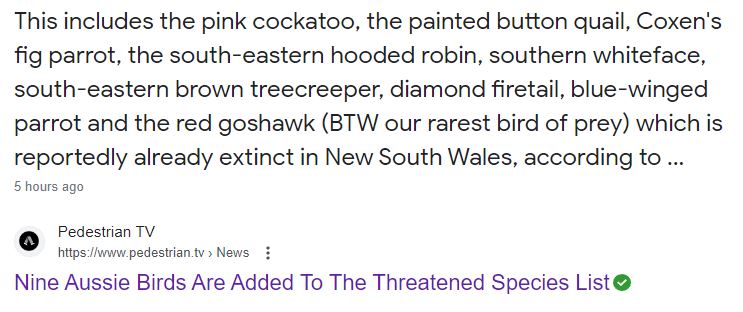You wouldn’t think there would be much to celebrate when a threatened species has its status uplisted because the risk
of it becoming extinct has increased. To have nine Australian birds uplisted on a single day as happened last week may at first seem very bleak indeed.
These listings have not come out of the blue, sparked by a single catastrophic event. The nine uplistings follow the recommendations of the 2020 Action
Plan for Australian Birds produced by BirdLife
Australia and Charles Darwin University, drawing on the expertise of hundreds of researchers who have studied and catalogued both the threats facing Australia’s birds and the actions needed to recover those teetering on the edge of extinction.
There will be more birds added to the threatened species list as the federal environment department plays catch-up after years of delays, but a listing should not be seen as a tragic conclusion.
It is a line in the sand, a moment of hope that we have reached a turning point in the fortunes of a threatened species.
They say the first step to recovery is to recognise you have a problem, however, unlike the institution that made that phrase famous, anonymity is the last thing that threatened species
need.
Extinction is often a quiet process, happening out of sight. Very few people would be
aware of the painted button-quail that lives on the Houtman Abrolhos islands offshore from the Western Australian town of Geraldton. These dapper yet inconspicuous ground-dwellers have been uplisted to endangered because this distinct subspecies
has now disappeared from one of only three islands they survive on, due to their habitat being overgrazed by introduced tammar wallabies.
Even if the wallabies were removed and the button-quails returned, there is an underlying ongoing threat of weeds choking out the remaining habitat on all three islands. This is why the
Abrolhos painted button-quail is considered one of the five Australian birds most likely to become extinct. It could easily happen with almost nobody mourning its loss. Similarly, Coxen’s fig-parrot – uplisted to critically endangered – may have already slipped
away unnoticed, with no verifiable sightings for decades in the dense Gondwana-era rainforests it once occupied.
People do notice the pink cockatoo. While the eastern subspecies lives in out-of-the-way parts of the arid zone, it is a favourite due to its glorious colours. Even the normally sober
field guides describe it as “flamboyant” and “beautiful”. Yet even such a stunning bird as this hasn’t avoided being placed in the endangered category.
The main cause of decline is a lack of suitable tree hollows for them to nest in. Their preferred nesting trees such as native cypress-pines are on average, 170
years old, and even those that survived clearing and are protected in conservation reserves are beginning to die and fall to the ground. The increasing frequency and intensity of fires and the overgrazing of seedlings by rabbits, goats and kangaroos
are speeding up the process and the placid pink cockatoo is losing out in the competition for the few remaining suitable hollows to galahs and feral bees. All this has led to a 71% decline in reporting rates over the past 40 years.
Similarly, it is past and ongoing land clearing of habitat that has driven a suite of once common and widespread woodland species, the south-eastern hooded robin, southern whiteface, south-eastern
brown treecreeper, diamond firetail and blue-winged parrot on to the threatened species list. Much of the damage has been done decades earlier and there is a lag between the triggering action and the loss of a species. Ecologists call this “extinction debt”.
Thus scattered pairs of hooded robins may survive the initial clearing of woodland, hanging on in suboptimal scraps of disconnected habitat. A species prone to predation in its open cup
nests and bullying from aggressive bird species that move into the disturbed habitat, their breeding success declines and any chicks that survive have few options to find new territories, as additional suitable woodland no longer exists.
The tragedy of our rarest bird of prey, the magnificent red goshawk – now newly listed as endangered – shows that we don’t seem to have learned much from our past mistakes. This bird-hunting
raptor ranges over vast tracts of tropical woodland searching for prey. Since the year that our current national threatened species act, the Environment Protection and Biodiversity Conservation Act (EPBC Act 1999) was introduced, 3m
hectares of potential woodland habitat within its former range have been destroyed, mostly in Queensland.
The red goshawk is now extinct in New South Wales and in Queensland is almost entirely absent anywhere south of Cape York. Yet the clearing continues, not only for pastoral and mining
purposes but now also for renewable energy projects such as the
proposed Upper Burdekin windfarm.
The developer acknowledges the project will have “significant residual impact” on red goshawks but bizarrely proposes that if one has a nest or roost tree near a windfarm, one mitigation
measure to lessen the risk of it being sliced by a turbine blade is to cut down the tree!
The hope that arises from a threatened species listing is that protection and recovery follow. This will only occur if we have strong, effective and well-resourced nature laws supporting
this. The federal environment minister, Tanya Plibersek, has pledged no
more extinctions in Australia. As we await her government’s response to the Samuel Review of the EPBC Act, while we know there will be more birds added to the threatened species list, we hope that we will see many come off it.
-
Sean Dooley is National Public Affairs Manager for BirdLife Australia.

